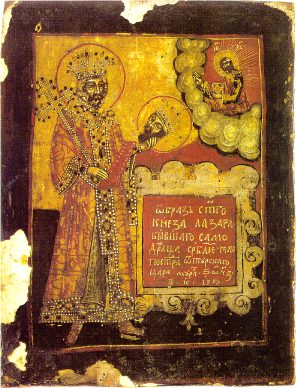 For
centuries, the personality of Prince Lazar (Hrebljanovic), a spouse of Princess
Milica, the last progeny of the Nemanjia dynasty, was remembered among the
Serbs as closely related to tragic destiny of the battle of Kosovo. Prince
Lazar was an enlightened and a humane ruler, a patron of arts. Following
an old tradition of the Nemanjic dynasty he built a hospital and an asylum
for the afflicted in his main endowment, the monastery Ravanica in 1391.
Soon after the tragedy at the field of Kosovo, the Church canonized Prince
Lazar and declared him a new martyr. On the icons after that, he was usually
presented as a "kefaloforos", because he was decapitated, thus
emphasizing the parallelism with great Christian martyrs St. George or St.
Dimitry. The celebration of Prince Lazar and his sacrifice for the faith
and his people is for every Christian an aspect of spiritual enlightenment.
In our folk tradition, it was always closely related to St. Vitus Day, an
ancient holiday of summer solstice (June 21-22) and undoubtedly of pre-Christian
origin that came shortly before the battle of Kosovo (June 28, 1389). The
Church made a compromise and started to celebrate this date as St. Vitus
Day, a Sicilian martyr from the third century and, by conferring to it a
Christian signification, in this way legalized an old pagan holiday of solar
character. For the Christian Church, the personality St. Vitus was not particularly
important in the sense of theology, but it is characteristic that his capability
of healing blindness, diseases of the eye and obsession is specially emphasized
in his biography. In our medieval fresco paintings his figure has been only
once painted in the Holy Virgin church of Pec's patriarchy. His relics are
kept in the most important church the Czech people, the cathedral of St.
Vitus in Prague. The Church also celebrates the June of 27, as a holiday
of the prophet Jelisije, who is, next to the prophet Ilija, one of the most
popular characters of the Old Testament, a man with a power to do miracles,
a doctor, a healer, a teacher and also an incarnation of a solar hero. Besides
St. Vitus Day, June 28 is also a holiday of the prophet Amos, a shepherd,
a fighter for the peopleOs justice and a martyr. It is known that all guardians
of cattle and shepherds are closely related to solar holidays and the cult
of light. Thus the symbolism of the radiant aureole of Prince Lazar's martyrdom
maintains an amazingly realistic parallelism with the people's celebration
of St. Vitus Day.
For
centuries, the personality of Prince Lazar (Hrebljanovic), a spouse of Princess
Milica, the last progeny of the Nemanjia dynasty, was remembered among the
Serbs as closely related to tragic destiny of the battle of Kosovo. Prince
Lazar was an enlightened and a humane ruler, a patron of arts. Following
an old tradition of the Nemanjic dynasty he built a hospital and an asylum
for the afflicted in his main endowment, the monastery Ravanica in 1391.
Soon after the tragedy at the field of Kosovo, the Church canonized Prince
Lazar and declared him a new martyr. On the icons after that, he was usually
presented as a "kefaloforos", because he was decapitated, thus
emphasizing the parallelism with great Christian martyrs St. George or St.
Dimitry. The celebration of Prince Lazar and his sacrifice for the faith
and his people is for every Christian an aspect of spiritual enlightenment.
In our folk tradition, it was always closely related to St. Vitus Day, an
ancient holiday of summer solstice (June 21-22) and undoubtedly of pre-Christian
origin that came shortly before the battle of Kosovo (June 28, 1389). The
Church made a compromise and started to celebrate this date as St. Vitus
Day, a Sicilian martyr from the third century and, by conferring to it a
Christian signification, in this way legalized an old pagan holiday of solar
character. For the Christian Church, the personality St. Vitus was not particularly
important in the sense of theology, but it is characteristic that his capability
of healing blindness, diseases of the eye and obsession is specially emphasized
in his biography. In our medieval fresco paintings his figure has been only
once painted in the Holy Virgin church of Pec's patriarchy. His relics are
kept in the most important church the Czech people, the cathedral of St.
Vitus in Prague. The Church also celebrates the June of 27, as a holiday
of the prophet Jelisije, who is, next to the prophet Ilija, one of the most
popular characters of the Old Testament, a man with a power to do miracles,
a doctor, a healer, a teacher and also an incarnation of a solar hero. Besides
St. Vitus Day, June 28 is also a holiday of the prophet Amos, a shepherd,
a fighter for the peopleOs justice and a martyr. It is known that all guardians
of cattle and shepherds are closely related to solar holidays and the cult
of light. Thus the symbolism of the radiant aureole of Prince Lazar's martyrdom
maintains an amazingly realistic parallelism with the people's celebration
of St. Vitus Day.by Ljubomir Vujaklija